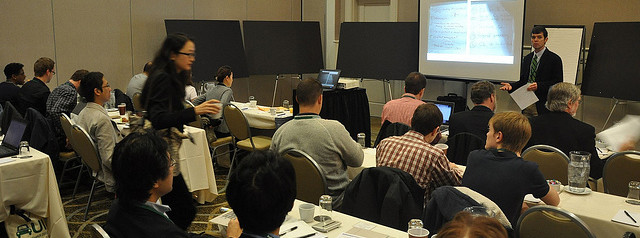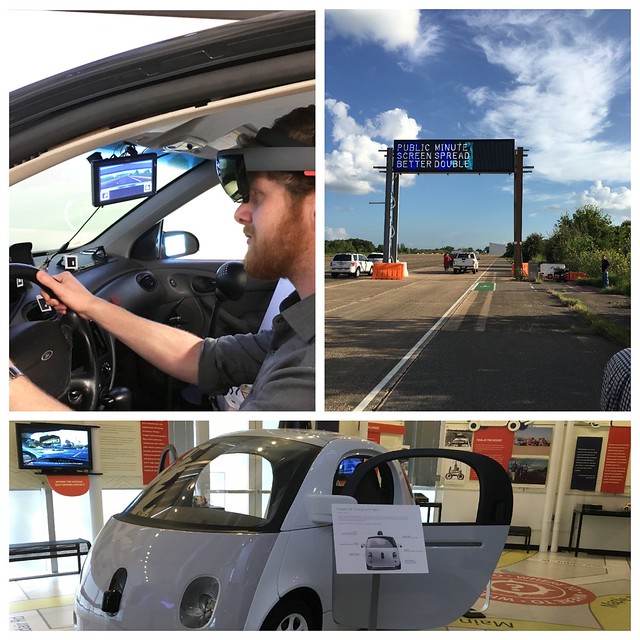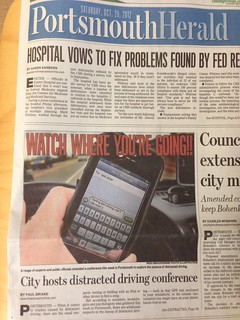If you’re interested in HMI for vehicles, you might enjoy reading my review article on the topic. The paper is part of the Foundations and Trends in HCI series by now publishers. You can download a complimentary copy until April 15, 2018.
Category Archives: auto-ui
Automotive UI: Expert discussion at CHI 2018

From top left to bottom right: Shamsi Iqbal, Ingrid Pettersson, Chris Janssen, Susanne Boll, Albrecht Schmidt, Alex Meschtscherjakov, Andrew Kun
I’ll moderate an expert discussion at this year’s CHI entitled Automotive User Interfaces: Expert Discussion. If you’re at CHI and interested in this topic, plan to attend on Thursday, April 26, 9-10:20, Room 516C.
Abstract: Automation is making significant advances in vehicles, with adaptive cruise control and lane keeping assistance being prominent technologies we encounter on the road today. How should we design user interactions for vehicles with automation? Panelists will lead the audience in discussions about (a) how to design interactions for driving-related and non-driving-related activities; (b) how the designs are affected by the availability of different types of vehicle automation, and how their effectiveness can be tested, (c) how we can approach the designs from the perspective of vehicle occupants, as well as from the perspective of other traffic participants, and (d) how to guide not only practice but also theory development about human-machine interaction for automated vehicles.
Discussion participants:
Susanne Boll, University of Oldenburg
Shamsi Iqbal, Microsoft Research
Christian P. Janssen, Utrecht University
Alexander Meschtscherjakov, University of Salzburg
Ingrid Pettersson, Volvo and Chalmers University
Albrecht Schmidt, Ludwig Maximilian University, Munich
AutomotiveUI 2017 – a brief photographic report
[flickr_set id=”72157687232855620″]
Coming up: CHI 2016 course on automotive user interfaces
At this year’s CHI conference Bastian Pfleging, Nora Broy and I will present a course introducing automotive user interfaces. Here’s the course abstract:
The objective of this course is to provide newcomers to Automotive User Interfaces with an introduction and overview of the field. The course will introduce the specifics and challenges of In-Vehicle User Interfaces that set this field apart from others. We will provide an overview of the specific requirements of AutomotiveUI, discuss the design of such interfaces, also with regard to standards and guidelines. We further outline how to evaluate interfaces in the car, discuss the challenges with upcoming automated driving and present trends and challenges in this domain.
Interested? Please register through the conference registration system and sign up for our course.
AutomotiveUI 2013: A brief report
At the end of October I was in Eindhoven for AutomotiveUI 2013. The conference was hosted by Jacques Terken, who along with his team did a splendid job: from the technical content, to the venue, to the banquet, and the invited demonstrations, everything was of high quality and ran smoothly. Thanks Jacques and colleagues!
The conference started with workshops, including our CLW 2013. The workshop was sponsored by Microsoft Research and it brought together over 30 participants. In addition to six contributed talks, the workshop featured two invited speakers. The keynote lecture was given by Klaus Bengler who discussed challenges with cooperative driving. Tuhin Diptiman discussed the implications of the 2013 NHTSA visual manual guidelines on the design of in-vehicle interfaces. Thanks Klaus and Tuhin for your engaging presentations! See pictures from CLW on Flickr.
The main conference included talks, posters and demos. Our group was productive: we had one talk and three posters. One of the memorable moments of the conference was the invited demos. I had a chance to ride in a TNO car using Cooperative Adaptive Cruise Control (CACC). See the video below (the driver and narrator is TNO researcher E. (Ellen) van Nunen – thanks Ellen!
See my pictures from the conference on Flickr.
LED Augmented Reality: Video Posted
During the 2012-2013 academic year I worked with a team of UNH ECE seniors to explore using an LED array as a low-cost heads-up display that would provide in-vehicle turn-by-turn navigation instructions. Our work will be published in the proceedings of AutomotiveUI 2013 [1]. Here’s the video introducing the experiment.
References
[1] Oskar Palinko, Andrew L. Kun, Zachary Cook, Adam Downey, Aaron Lecomte, Meredith Swanson, Tina Tomaszewski, “Towards Augmented Reality Navigation Using Affordable Technology,” AutomotiveUI 2013
CLW 2012 report

Background
The 2012 Cognitive Load and In-Vehicle Human-Machine Interaction workshop (CLW 2012) was held in conjunction with AutomotiveUI 2012 in Portsmouth, NH. The workshop was the second CLW in a row – CLW 2011 was held at AutomotiveUI 2011 in Salzburg, Austria.
Overview
Over 35 people from government, industry and academia attended CLW 2012.
For CLW 2012 the organizers made the decision to involve a large number of experts in the workshop, instead of only including contributions by authors responding to our CFP. Thus, the CLW 2012 program included three expert presentations, as well as a government-industry panel with four participants. Each of these expert participants discussed unique aspects of estimating and utilizing cognitive load for the design and deployment of in-vehicle human-machine interfaces.
Bryan Reimer opened the expert presentations with a discussion of the relationship between driver distraction and cognitive load. Next, Bruce Mehler discussed practical issues in estimating cognitive load from physiological measures. Finally, Paul Green discussed how cognitive load measures might fit in with the NHTSA visual-manual guidelines.
The expert presentations were followed by a government-industry panel. Chris Monk (Human Factors Division Chief at NHTSA) presented the NHTSA perspective on cognitive load and HMI design. Jim Foley (Toyota Technical Center, USA) introduced the OEM perspective. Scott Pennock (QNX & ITU-T Focus Group on Driver Distraction) introduced issues related to standardization. Garrett Weinberg (Nuance) focused on issues related to voice user interfaces.
Following these presentations, and the accompanying lively discussions, workshop participants viewed eight posters.
Evaluation
At the end of the workshop we asked participants to indicate their level of agreement with these four statements:
- I found the workshop to be useful.
- I enjoyed the workshop.
- I would attend a similar workshop at a future AutomotiveUI conference.
- This workshop is the reason I am attending AutomotiveUI 2011.
The responses of 13 participants are shown below (the workshop organizers in attendance did not complete the questionnaire). They indicate that the workshop was a success.

Next steps
Since the conclusion of CLW 2012 co-organizers Peter Froehlich and Andrew Kun joined forces with Susanne Boll and Jim Foley to organize a workshop at CHI 2013 on automotive user interfaces. Also, a proposal for CLW 2013 at AutomotiveUI 2013 is in the works.
Thank you presenters and participants!
The organizers would like to extend our warmest appreciation to all of the presenters for the work that went into the expert presentations, the panel discussion, and the poster papers and presentations. We would also like to thank all of the workshop attendees for raising questions, discussing posters, and sharing their knowledge and expertise.
You can see more pictures from CLW 2012 on Flickr.
This report is also available on the CLW website.
AutomotiveUI 2012 report published in IEEE Pervasive Computing
The report on the AutomotiveUI 2012 conference, co-authored by Linda Boyle, Bryan Reimer, Andreas Riener and me, was recently published by IEEE Pervasive Computing [1]. The reference on this page points to my final version of the paper. You can also download the paper with the published layout directly from the IEEE here.
References
[1] Andrew L. Kun, Linda Ng Boyle, Bryan Reimer, Andreas Riener, “AutomotiveUI: Interacting with technology in vehicles,” IEEE Pervasive Computing, April-June 2103
AutomotiveUI 2012 covered in local media
AutomotiveUI 2012 was covered in three excellent articles in local media in New Hampshire.
First, Paul Briand introduced the conference in a front-page article in the October 20 issue of the Portsmouth Herald. I am glad that Paul pointed out that this is a multi-disciplinary conference, and also that he included nice quotes from UNH researcher Oskar Palinko, who touched upon visual and cognitive distractions.
Next, UNH’s Beth Potier discussed our work in an excellent article in UNH Today. One of the highlights of Beth’s article for me was that she referenced two studies – our work on augmented reality published at MobileHCI 2011, and follow-on work being conducted by a team of UNH ECE seniors, as part of their senior project. Another highlight was this illustration by Bridget Finnegan:
Finally, Liz Markhlevskaya discussed the conference, and our work at UNH, in an article in the Foster’s Daily Democrat. I really like the fact that Liz clearly connected our work on deploying the Project54 system with our more recent driving simulator-based work.
AutomotiveUI 2012 hosts female 8th graders
Are you concerned about the low number of female graduates in fields such as electrical and computer engineering and computer science? I am – the numbers are truly dismal.
In an attempt to improve the situation a little, I organized a visit of 21 female 8th graders to AutomotiveUI 2012. The students attend the Armand R. Dupont School in Allenstown, New Hampshire. They came to the conference with their math teacher, Michelle Kelly. Michelle and I have been planning this trip since this summer, when she conducted research in my lab at UNH.
Michelle’s students discussed the conference, as well as the work of engineers and scientists, with three women attending the conference: Linda Boyle (professor at University of Washington), Nora Broy (researcher at BMW) and Chee Lee Cheong (undergrad exchange student at UNH ECE). They asked many questions and were quite engaged in the ensuing conversations. I am confident that they left the conference feeling that science and engineering can be exciting careers (and Michelle agrees).







